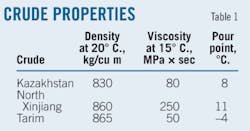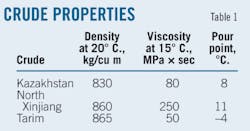Development of the Khurais complex required optimization of various technologies such horizontal laterals, downhole pumps, and smart completion equipment.
This concluding part of a two-part series discusses methods used for designing optimum well completions. The first part (OGJ, Feb. 22, 2010, p. 37) covered methods for determining the geologic and reservoir characteristics of the fields.
Horizontal laterals
After determination of the withdrawal rate allocations and required well number, as discussed in Part 1, the next step in optimizing the field development was to evaluate well attributes, such as well length, placement, and horizontal lateral orientation. This involved numerous studies for assessing the type of wells and configurations, surface facilities, and processing requirements to minimize the development cost.
Horizontal wells proved more advantageous than vertical wells in terms of productivity, sweep, and recovery. They also maintained an edge in cost-effectiveness.
The two criteria used for determining horizontal length were the productivity index (PI), which determined the well rate, and pressure drawdown.
As discussed in Part 1, multiobjective function and experimental design simulation models determined the desired production rate for each area and each well. Knowing the PI relationship of vertical to horizontal well performance made possible the calculation of the length of the lateral.
This length was in turn optimized by making sure it is long enough to provide a drawdown that inhibits coning either through the matrix or through heterogeneities, such as fractures or high permeability thief zones connected to fractures.
After the determination of the horizontal length, the next step determined the placement of this lateral. For this both analogy and simulation modeling played major roles in the decision.
A neighboring field with reservoir fluid, rock properties, and depositional, as well as migration settings similar to Khurais has a bottoms-up reservoir sweep. This sweep pattern was reproduced in the Khurais dual porosity-permeability reservoir simulation models and provided the basis for placing the horizontal laterals in the top pay interval of Khurais reservoirs. Real-time geosteering made sure that the horizontal laterals went through the best pay possible.
The design optimized the orientation of the azimuth of the horizontal laterals along the maximum stress direction of North 80o East. This is the optimum orientation to avoid the majority of the open fractures as observed in both production performance (in terms of PI and well rates), and in numerous image log runs in neighboring fields.
Because well rates can be met from the reservoir's excellent matrix permeability, the avoidance of open fractures mitigates the premature water breakthrough into the wellbore.
Technology applications
The technology applications started with mud design, for which the company's research and development center formulated a special mix of oil-based mud to minimize formation damage for improving the productivity without resorting to acid treatment if water-based mud was used.
Because the wells did not need stimulation, this reduced rig times, which helped further lower the development cost. This strategy was because PI tests in newly drilled wells indicated excellent productivities without the need for stimulation treatments.
Another feature of the technology applications was the running of resistivity image logs routinely every time the horizontal wells experienced lost circulation. These images were usually run in combination with acoustic logs to enhance the resolution in identifying fracture swarms. Location of the fracture swarms was needed for the design of passive inflow control with internal control devices (ICDs) in some wells as a preventive mode to mitigate future premature water breakthrough into the wellbores (Fig. 1).
The technologies discussed so far reflect fit-for-purpose short-term necessity in development of this complex; however, technology applications in Khurais also will support the long-term vision, which prescribes a strategy that combines the well architecture together with the rapidly evolving downhole technologies. Because the field is in the initial stage of production, when most if not all wells produce without water, the wells currently do not need downhole production control.
| In anticipation of water encroachment, wells have a large borehole (left photo) equipped with an electric submersible pump and Y-tools for accommodating smart completions and wellbore accessibility (Fig. 2). A long-term test (right photo) will determine the effectiveness of dual-reservoir production with a smart completion (Fig. 3). |
In anticipating water encroachment years in the future, the well design includes large 81⁄2-in. wellbores (Fig. 2) completed with Y-tools for wellbore accessibility. The large wellbores will accommodate the installation of the next-generation of smart completions (SCs) with internal control valves (ICVs), or passive inflow control with ICD completions together with futuristic, highly efficient coiled-tubing deployed electrical submersible pumps (ESPs).
The next-generation downhole equipment will have a fit-for-purpose design, with the tactical need in collaboration with the exploration and petroleum engineering center, advanced research center at Saudi Aramco, service companies, and-or joint-venture industry institutions.
In support of the future design, the wells will have additional downhole logs, such as image and nuclear magnetic resonance, as well as horizontal well multiphase flowmeters to assist in the understanding of the reservoir behavior and in improving the technology application requirements to maximize the well productivity, minimize the cost, and enhance oil recovery.
In the case of multilateral maximum reservoir contact (MRC) wells1 and dual-reservoir (Arab-D and Hanifa) commingled production, Saudi Aramco is field testing a technology application of SC with wet-connect ESPs for long-term performance in a well that had a successful initial completion and installation.
While Saudi Aramco completed most wells as smart-ready for the application of this technology, as needed, field tests continue for the purpose of future optimization.
In the case of dual-reservoir commingled production, a field test is under way of a horizontal well for long-term performance. The well already had a successful initial completion and installation with individual laterals placed in each reservoir (Fig. 3). The well has ESPs and smart control in each lateral to provide the means to balance flow contribution from individual reservoirs and avoid interreservoir cross flow.
As discussed extensively in Reference 2, the new completion is different from other systems used previously in the industry. It uses a redesigned hydraulic disconnect tool (wet-connect) to make the connection between the upper completion with the ESP and the lower completion that has the SC. This system ensures that routine ESP repair can be made without retrieval of the SC.
This integrated system enables commingling of the two producing reservoirs and provides flexibility to control and alter withdrawal rates from each reservoir when the producing strategy requires different withdrawal options.
In the far-south Khurais south dome area, the reservoir has a lower PI and flatter structural relief with underlying water. In this area, multilateral MRC wells (Fig. 4) provide the necessary production rates with low-pressure drawdown, mitigating any water coning, either through the matrix or heterogeneities.
The area also has a smart-completion field test. The other MRC wells have the mother bores completed in smart-ready mode with in-place 7-in. liners to ensure the wellbore configurations are adequate for next-generation smart equipment with wet-connects.
Intelligent field initiative
All technology applications in the Khurais complex that satisfy both immediate needs or long-term visions operate in the intelligent field (I-Field) mode with all producing wells either equipped with smart sensors as part of the SC or as part of downhole smart ESP.
A central operating command center houses all of the controls for these producing wells, as well as injection wells. The center regulates oil withdrawals and water injection rates in real time.
For mitigating water coning or cusping in producing wells, it is important to monitor and control through the variable-speed ESP the pressure drawdown for individual wells.
For an injection well, it is vital that injection rates be distributed to ensure the flood front conformance through proper injection-production allocation.
Monitoring reservoir behavior through an I-Field is not only through the producers and injectors, but also through a network of dedicated observation wells as part of a master surveillance plan. These wells are placed strategically to yield vital information in real time, needed for quick response as part of the production-injection strategy.
The master surveillance system, as its name implies, is proving its worth before the commissioning of the field production facilities because the system provides in real time, at the time of this article, information on the reservoir behavior during the field-wide interference tests. These tests provide a once-in-a-lifetime opportunity to acquire pulsing data for evaluating reservoir performance and for updating production-injection strategies after the field's commissioning.
It is also interesting to note that, at the time of this article, well tests indicate productivities of the horizontal wells are three to five times more than those of the current few existing vertical wells in the fields. The complex would have had a higher development cost if it had vertical wells.
Field-wide interference tests in Khurais indicate an excellent reservoir connectivity and pressure propagation from peripheral injection to in-field producers, setting the stage to ensure that the Khurais complex will produce efficiently, safely, and economically.
Acknowledgments
The authors thank Saudi Aramco management for its support and permission to present the information contained in this article. The authors acknowledge the contributions of all the members of the Khurais development team, especially Abdel Nasser Abitrabi (KRMD), Khalid Sheddi, Mohammed Yaacob, and John Cole (RCD), Bevan Yuen (RSD), Fahad Bani (drilling engineering), and Salman Gamber (production engineering).
References
1. Afaleg, N.I., et al., "Design and Deployment of Maximum Reservoir Contact Wells with Smart Completions in the Development of a Carbonate Reservoir," Paper No. SPE 93138, SPE Asia Pacific Oil and Gas Conference and Exhibition, Jakarta, Apr. 5-7, 2005.
2. Ansah, J., et al., "Two-Zone Commingled Production Using Intelligent Well Completion Coupled with ESP through a Hydraulic Disconnect Tool," Paper No. SPE 120303, SPE Middle East Oil and Gas Show, Bahrain, Mar. 15-18, 2009.
More Oil & Gas Journal Current Issue Articles
More Oil & Gas Journal Archives Issue Articles
View Oil and Gas Articles on PennEnergy.com




